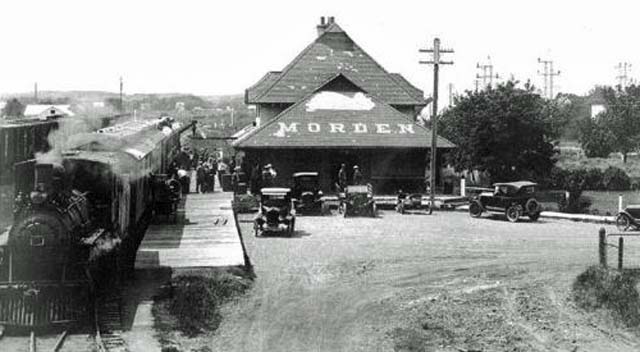
2012
|


The Canadian Pacific Railway Type 9 station at Morden - Date/Photographer unknown.
10 July 2012
Writer Preserving Our Railway Heritage
Morden Manitoba - Ron Brown is someone who notices what others drive by.
It's why he's written 23 books on topics like railroads, ghost towns, and back roads sites. His latest book was released 30 Jun 2012, and Brown said it's a
close look at an important part of our history.
"Rails Across the Prairies" takes a close look at the influence of rail construction and travel on development in Canada's heartland.
"Arriving fresh from Europe, settlers used ferry services on the Assiniboine and North Saskatchewan Rivers until the first steam engine arrived in the
region," a press release stated. "The building of the railways soon followed, inciting rivalries among different rail owners, and establishing new
towns along the line."
"Rails Across the Prairies" tells the story of how rail lines came to be, where they were abandoned, and where they remain today. It looks at
remaining landmarks, vacant ghost towns, and elevators, as well as those rail stations that survived, many as museums and interpretive centres.
This isn't Brown's first book to deal with railways. He published "The Last Stop: Ontario's Heritage Railway Stations" in 2002, "The Train
Doesn't Stop Here Anymore" in 2008, and "In Search of the Grand Trunk and Other Ghost Rail Lines in Ontario" in 2011.
He said when he began researching this book, he found many small communities already had the research completed. "There's been a lot of great stuff
written in the prairies," he said.
Brown has been writing books since the late 1970s and said the research part is much quicker than it used to be. "An awful lot more research for this book
was done online," he said. "It's amazing the amount of work that's been done locally."
Although many communities are touched on in the book, there were several things that stood out for Brown.
He said the aqueduct in Brooks, Alberta, was one. "There's nothing else like it in Canada," he said. "It's an amazing piece of engineering."
He was also saddened that despite federal heritage designation, some train stations are simply falling apart. He talked about the train station in Biggar that
was "saved" by a designation but now has trees growing through it, or the historical rail hotel in Moose Jaw that was razed by a developer. "It
bothers me because it shows they don't care..." he said of the Moose Jaw incident.
But Brown said there's plenty of people doing the right things as well. Biggar also is preserving a roundhouse, something that's also extremely rare today.
"I know we've lost a lot," he said. "But local folks seem to be picking up the slack."
The book includes detail about many communities including the following from southern Manitoba.
Emerson
Manitoba's government gave approval for Northern Pacific to build a rail line south from Winnipeg to the U.S. border at Emerson and west to Brandon.
"By travelling south, passengers could transfer to the Northern Pacific Railway and voyage to the west coast, all in competition with the CPR," the
book explains.
Because of financial difficulties the line was taken over by William McKenzie and Donald Mann.
The 1960's saw the elimination of 80 percent of railway stations. Of the 2,000 stations built across the three prairie provinces only 720 remained in the
mid 1990s, and more than 90 percent had been dragged off to become as the book states, barns, private homes, or restaurants.
The Heritage Railway Station Protection Act came in time to save some. Manitoba had 18 on that list including Emerson.
The book also takes a close look at individual stations.
Emerson's was also a place where goods entering the country had to be inspected.
It was built in 1914, and is "topped by a wide, steep, roof over a single storey with a bay window centrally placed."
It was painted CPR red, and although it's closed and boarded up right now, it is a protected station under the Heritage Railway Station Protection Act.
Morden
This station had a unique claim to fame as being a rare CPR style found in less than 10 locations across the prairies.
"Designed by R.B. Pratt in 1899, the steep roofline is topped with a flared peak and hipped eyebrow dormers, which earned this style the Chinese Pagoda
moniker," the book stated.
A similar station was found in Winkler as well as Boissevain, Hartney, Virden, and Kenton in Manitoba.
The station was built in 1906, closed in the 1960's, and moved to the Pembina Thesherman's Museum in 1975.
Carman
This station was larger than the typical rural stations and is categorized as a class 2 station.
"It presents swings on each side of the main building, each with a hip dormer. The wing to the east was the freight room," the book states.
Carman's station was built in 1902 and is owned by the Town of Carman. It was designated as a Manitoba Municipal Heritage Site in 2003.
"Rails Across the Prairies" is available at a book store near you and as an eBook.
Greg Vandermeulen.

Book cover - Date/Photographer unknown.

|


|
Vancouver Island
British Columbia
Canada
|
|